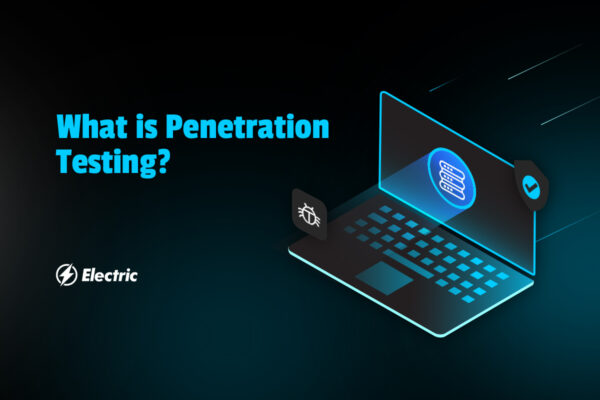
No matter how you get your news, you know cybersecurity has been a topic of concern lately. In May 2021, President Biden signed an Executive Order enabling government agencies to exchange attack information and to work with the private sector to strengthen America’s cyber defenses. The federal government should be concerned.
Our Electric 2021 Cybersecurity Report found that:
-
71% of organizations had an employee succumb to a social engineering attack.
-
96% of organizations have made changes to their security strategy as a result of more people working remotely.
It’s no wonder that a cyber attempt happens every 11 seconds.
Cybersecurity tools exist to help organizations protect their infrastructure from cyber attacks. Some tools are familiar such as firewalls and antivirus software; others, such as penetration testing, are not. Yet, pen testing, as it’s called, is one of the best ways to determine a system’s cybersecurity risk.
What is Penetration Testing?
Penetration testing (or pen testing) is a technique used by organizations to identify, safely exploit, and help eliminate potential weaknesses in an organization’s infrastructure. Using different methods and tools, companies simulate cyber attacks to exercise their systems to highlight vulnerabilities. The objective is to determine how far a hypothetical hacker could penetrate an infrastructure despite a company’s security measures and protocols. It can also be used to test compliance regulations.
The 6 Types of Penetration Testing
Pen testing focuses on all areas of a company’s infrastructure, whether on-premise or in the cloud. The names or types of these test vary, but what is important is that the following areas are tested:
1. Internal Infrastructure
Internal testing focuses on the devices such as firewalls, servers, routers, or switches that could come under attack. Information on internal IPs, subnets, and sites is needed to ensure a comprehensive test plan can be devised.
2. External Infrastructure
Internet- or customer-facing structures are attacked to assess how well they can withstand an attack. These penetration tests are especially needed in environments where financial transactions are involved. The PCI-DSS standard requires penetration testing as part of its compliance guidelines.
3. Network Endpoints and Security Devices
With more employees working from home and IoT devices becoming more prevalent, testing security devices and endpoints becomes even more essential to maintaining a secure infrastructure. One poorly configured device is all a hacker needs to gain access to critical digital assets.
4. Wireless Networks and Devices
Pen testers will need to know the number of wireless networks and devices that are part of a company’s infrastructure. If the company operates a wireless local area network, wireless protocols should be tested, including Bluetooth. The testing can detect unauthorized access points and weak encryption.
Wireless penetration testing is simulated on-site to determine how secure the connections between all devices connected to your business Wi-Fi network are. This includes connections to:
-
Tablets
-
IoT devices
-
Mobile devices
-
Laptops
The testing has to happen on-site since the hacker must be in the range of the wireless network to access it. The tester may perform the following in the process:
-
Wireless reconnaissance
-
Vulnerability research
-
Exploitation
-
Reporting
5. Mobile Applications and Devices
If an organization has mobile applications, they need to be pen tested on Android and iOS devices. It’s important that authentication and session handling are tested as well as any API calls. As more mobile applications are deployed, the opportunity for compromise increases.
6. Web Applications
Web applications provide bad actors with a wealth of possibilities. Penetration testing should look for coding, design, and development weaknesses. Before beginning testing, all possible applications should be identified, including the number of static and dynamic pages. Data entry fields should be probed.
Both manual and automated tests are simulated on attacks against web applications to detect security weaknesses, vulnerabilities, and other ways malicious hackers can gain unlawful access to sensitive data.
This type of penetration testing is used to test for the following scenarios:
-
SQL injection
-
Security misconfigurations
-
File upload flaws
-
Cross-site scripting
-
Password cracking
-
Broken authentication and session management
-
Caching servers attacks
-
Cross-site request forgery
Penetration Testing vs. Vulnerability Scanning
Penetration tests are not the same as vulnerability assessments. Vulnerability assessments scan a company’s network looking for known weaknesses. After the scan is complete, a list of weaknesses is produced, usually in priority order. IT departments use the list to determine which vulnerabilities to address first. Because of the routine nature of the assessments, vulnerability scans are usually performed automatically.
Penetration testing is performed by individuals trying to mimic bad actors. The simulation is carefully planned to target crucial areas in the network infrastructure. They are designed to strengthen cybersecurity; however, they can also improve site and application performance.
During testing, data is collected that can be analyzed to pinpoint delays in load or response times, for example. Well-designed and executed penetration tests help businesses:
-
Manage vulnerabilities
-
Comply with regulations
-
Sustain network uptime
-
Improve reputation
Testing can also protect against financial loss, strengthen business relationships, and help prioritize cybersecurity spending.
Benefits of Penetration Testing
The five most important benefits of penetration testing include:
-
Improving Security Infrastructure
-
Mitigating Financial Loss
-
Protecting Clients and Partners
-
Protecting Reputation
-
Maintaining Compliance
Cybersecurity may be the focus of pen testing, but the benefits go far beyond defending against a cyberattack. Penetration testing mitigates the financial risks associated with data breaches and minimizes the long-term damage to an organization’s reputation and business relationships.
How to Do a Penetration Test
No two operating environments are the same, so no two penetration tests can be the same. Organizations use different hardware, software, even different browsers, and operating systems. Each configuration requires different tests. Although there are documented methods for performing pen tests, each test should be tailored to the specific environment.
Penetration testing typically falls into three phases:
-
Planning and Discovery
-
Attack
-
Reporting
Before starting a penetration exercise, make sure to review the methodologies to be used. They should be tailored not only to the specific environment but also to the industry. Whether it is healthcare or financial services, industries have compliance requirements that should be part of any test plan.
Planning and Discovery
As mentioned above, the form of pen testing depends on the level of knowledge and access granted to the tester. These levels include the following:
-
Black-box testing simulates the average hacker’s attempts to compromise a system. It identifies the vulnerabilities of a system from outside the network.
-
White-box testers have access to source code, network architecture, and documentation. It is the most comprehensive penetration testing methodology.
-
Grey-box testing looks at vulnerabilities from inside the network. Testers have user access with elevated privileges to simulate insider attacks.
Each level tests a different configuration, so it is important to identify the best methodology for the situation to be tested.
Attack
Testers use scripts created for the specific environment. If they find a vulnerability, they attempt to exploit it to determine how much damage a hacker could do to the system. Depending on specific needs, testers may perform any of the following tests:
-
External. Tests the public-facing components accessed via the internet or other external networks.
-
Internal. Tests access capabilities from behind the firewall.
-
Wireless. Tests wireless connections for possible weaknesses.
-
Web Application. Tests web applications for vulnerabilities that can be exploited.
-
Social Engineering. Tests social engineering tactics used by hackers to gain network access.
Because the number of tests can be extensive, organizations must have a clearly defined project scope.
Reporting
When test results are reviewed by security personnel, they should look at:
-
Specific vulnerabilities that were exploited
-
Sensitive data that was accessed
-
Length of penetration
From this information, priorities can be set so critical vulnerabilities can be addressed first.
These days there is so much to consider when it comes to maintaining security for your organization. With many individuals working remotely, it’s important to be mindful of the ways nefarious actors could bypass your organization’s security controls.
Let Electric’s squadron of seasoned IT professionals guide your team through selecting the proper solutions to protect your sensitive data. Contact us today to learn more.



